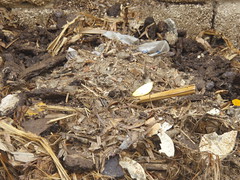This is the first post of series that will be published over the next few weeks. If all goes well it should be approximately 18 days long. If we have not been that good it could take much longer. On April 12 we assembled a compost pile in the front yard of our residence in Jordan. It would be difficult to list all of the different materials that went into the building of the pile, because we don't really know ourselves. The rule of thumb - "If it was alive once, it can be composted". We do know that banana leaves, mesquite leaves, goat manure, dried up old bread, sheep's wool, guava leaves, wood ash, chicken poop, sticks and stones, kitchen scraps, snails and bugs went in. It is likely that some plastic made its way into the pile as well, this will be removed as it goes. We hope that countless species of microscopic life made it in as well. It is the diversity of the life in a finished compost that makes it so valuable to a garden. It is the flourishing of microscopic life that we are trying to encourage by assembling a compost. All of the fungi and bacteria found in a good finished compost are around us at all times. When building a compost we bring the elements together and allow life to do the rest.
Water is the "keystone" element of any compost pile, as it is the keystone element of any life system. Life uses water to conduct its interactions. It is the interactions in a compost pile that we wish to encourage. A lot of water is used to start a compost pile, as most of the materials are usually quite dry. A healthy pile will have moisture content of about 50%. This might seem a wasteful use of resources in a region such as the Jordan valley. However, the value of compost in a garden can be seen within a few months. This compost pile will also be used at the project site to help build soil biology around trees that will be planted in the coming weeks.
We are following a composting technique known as the “Berkley Method.” It is a labour intensive method, but it can yield a reasonable product in short period of time. If all is going well we will be making the first turn on April 16th and every second day to follow until the compost is relatively cool and finished. The plan is to blog a picture and some observation at every turn.
Right now the pile is covered with a plastic sheet and holding its moisture so things are looking good thus far.
Will run-away climate change make drought permanent?
18 years ago






No comments:
Post a Comment